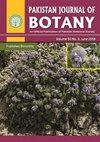丁香假单胞菌对芒果的致病性可导致严重的根尖坏死
IF 0.9
4区 生物学
Q4 PLANT SCIENCES
引用次数: 0
摘要
本文章由计算机程序翻译,如有差异,请以英文原文为准。
Pseudomonas syringae induced pathogenicity in Mangifera indica leads to severe apical necrosis
Mango apical necrosis caused by Pseudomonas syringae has been documented by the current inquiry. Punjab, Pakistan’s healthy mango output is being threatened by bacterial apical necrosis. Thirty-eight orchards were chosen in three districts (Multan, Khanewal, and Muzaffargarh) with the aim of evaluating the prevalence, incidence, and severity of disease in order to validate the status of mango apical necrosis. According to survey, disorder was widely distributed with 100% prevalence in Multan, Khanewal and 70% in Muzaffargarh. Bacterial apical necrosis highest (0.9%) incidence was recorded in Multan, Khanewal and lowest (0.5%) in Muzaffargarh. Pathogens were identified based on 16S rRNA gene analysis as Pseudomonas syringae (strain ICMP 3023, NCPPB 281, ATCC 19310, tomato strain DC3000), Pseudomonas putida (strain ATCC 12633), Pseudomonas savastanoi (ATCC 13522) and Pseudomonas syringae pv . phaseolicola (1448A). After the first, second, and third weeks of artificial inoculation, results for pathogenicity were obtained. Tobacco, potato tubers, mango leaves, tomatoes, and lemon fruit samples were tested against all the identified strains and lemon was found vulnerable among them. The host least prone to P. syringae infection was the potato. Toxin was extracted by methanol: chloroform from the cell-free culture of P. syringae for toxin analysis. P.S. ICMP 3023, one of the four P. syringae pv isolates, was the most virulent and caused illness in all the host plants. In the future, TLC analysis of the mango apical necrosis toxins will be necessary, and research will be beneficial for management techniques.
求助全文
通过发布文献求助,成功后即可免费获取论文全文。
去求助
来源期刊

Pakistan Journal of Botany
生物-植物科学
CiteScore
2.40
自引率
8.30%
发文量
218
审稿时长
8.4 months
期刊介绍:
The Pakistan Journal of Botany is an international journal for publication of original research in plant science. Work on all plant groups, including fossil plants, is published. The journal publishes in the areas of: ecology and ecophysiology; conservation biology and biodiversity; forest biology and management; cell and molecular biology; paleobotany; reproductive biology and genetics; mycology and pathology; and structure and development.
 求助内容:
求助内容: 应助结果提醒方式:
应助结果提醒方式:


